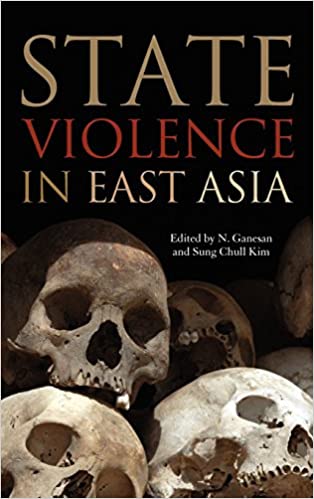
Edited by Narayanan Ganesan and Sung Chull Kim (University Press of Kentucky, 2013)
State Violence in East Asia is the publication arising from a project with a similar title that was funded by the Hiroshima Peace Institute. The project involved two workshops that were hosted in December 2009 in Hong Kong and September 2010 in Seoul. The first workshop was co-hosted with the City University of Hong Kong and the second was hosted in collaboration with the Korean Institute of National Unification (KINU). Both workshops were also generously co-funded by the Asian Political and International Studies Association (APISA) and the German Konrad Adenauer Stiftung (KAS).
The book presents theories that deal with state violence, especially that which occurred during the time of state formation and regime transition or consolidation. It also has seven chapters that detail state violence in East Asia – three cases from China, Japan and South Korea in Northeast Asia and five cases from Cambodia, Indonesia, Myanmar, the Philippines and Thailand in Southeast Asia. This volume highlights the political and cultural dynamics that lead to state-sanctioned violence and discusses ways to prevent such incidents in the future.
[Contents]
Introduction: Conceiving State Violence, Justice, and Transition in East Asia (Sung Chull Kim and N. Ganesan)
- Interpreting State Violence in Asian Settings (Vince Boudreau)
- From the Streets to the National Assembly: Democratic Transition and Demands for Truth about Kwangju in South Korea (Namhee Lee)
- Unsettled State Violence in Japan: The Okinawa Incident (Hayashi Hirofumi)
- Popular Views of State Violence in China: The Tiananmen Incident (Jeffrey N. Wasserstrom and Kate Merkel-Hess)
- Mass Atrocities in Cambodia under the Khmer Rouge Reign of Terror (Sorpong Peou)
- Counterrevolutionary Violence in Indonesia (Douglas Kammen)
- Getting Away with Murder in Thailand: State Violence and Impunity in Phatthalung (Tyrell Haberkorn)
- The End of an Illusion: The Mendiola Massacre and Political Transition in Post-Marcos Philippines (Rommel A. Curaming)
- The Four-Eights Democratic Movement and Political Repression in Myanmar (Kyaw Yin Hlaing)
Conclusion: Comparing State Violence and Reconciliation across East Asia (N. Ganesan and Sung Chull Kim)
東アジアにおける国家暴力
ナラヤナン・ガネサン、金聖哲/編(University Press of Kentucky、2013年)
本書は広島平和研究所のプロジェクト研究「東アジアにおける国家暴力と政治変動」の成果である。同プロジェクト研究の期間中、2009年12月には香港において香港市立大学との共催によるワークショップを、また、2010年9月にはソウルにおいて韓国統一研究院(KINU)との共催によるワークショップを開催した。これらのワークショップ開催には、マレーシアのアジア政治国際学会(APISA)、およびドイツのコンラート・アデナウアー財団(KAS)から財政補助を得た。
本書の内容は、東アジアにおける悲惨な国家暴力を検証するものであるが、特に国家形成期、また政権の移行期や土台固めの時期に行われた国家暴力に焦点を当てている。全9章の内7章で東アジアにおける国家暴力を取り上げ、北東アジアの中国、日本、韓国の事例3件、東南アジアのカンボジア、インドネシア、ミャンマー、フィリピン、タイの事例5件を紹介している。国による暴力の政治的力学、文化的力学を浮き彫りにし、国家暴力を阻止する道を探る一冊である。※英語版のみ
